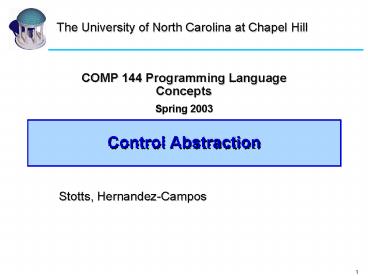Control Abstraction - PowerPoint PPT Presentation
1 / 16
Title:
Control Abstraction
Description:
Most data structures include some number of control abstractions. 3. Subroutines ... Restore registers including ra (based on sp) Add frame size to sp. Return ... – PowerPoint PPT presentation
Number of Views:26
Avg rating:3.0/5.0
Title: Control Abstraction
1
Control Abstraction
The University of North Carolina at Chapel Hill
- COMP 144 Programming Language Concepts
- Spring 2003
Stotts, Hernandez-Campos
2
Abstraction
- Programming languages support the binding of
names with potentially complex program fragments
that can be used through an interface - Programmers only need to know about the purpose
of the fragment rather than its implementation ?
Abstraction - A control abstraction performs a well-defined
operation - Subroutines
- A data abstraction represents information
- Data structures
- Most data structures include some number of
control abstractions
3
Subroutines
- Execute an operation on behalf of a calling
program unit - Subroutines can be parameterized
- The parameters in the definition of the function
are known as formal parameters - The parameters passed in the subroutine call are
known as actual parameters or arguments - At the time of the call, actual parameters are
mapped to formal parameters - Functions are subroutines that return a value,
while procedures are subroutines that do not
return a value
4
Subroutine Frames
1001 A(3) 2001 int A(int n) int m
n n return m A(n-1)
- Each subroutines requires a subroutine frame
(a.k.a activation record) to keep track of - Arguments and return values
- Local variables and temporaries
- Bookkeeping information
- When a subroutine returns, its frame is removed
5
Call StackRecursive Subroutine
A
m
A
A
A
n
A
6
C Example
- Stack pointer sp
- Top of the frame stack
- Frame pointer fp
- Access to arguments and locals via offset of fp
- They differ if temporary space is allocated in
the stack
7
C Example
- Stack pointer sp
- Top of the frame stack
- Frame pointer fp
- Access to arguments and locals via offset of fp
- They differ if temporary space is allocated in
the stack
8
Stack Maintenance
- Calling sequence (by caller) and prologue (by
callee) are executed in the way into the
subroutine - Pass parameters
- Save return address
- Change program counter
- Change stack pointer to allocate stack space
- Save registers (including frame pointer)
- Change frame pointer to new frame
- Initialization code
- Separation of tasks?
- As much as possible in the callee (only once in
the program)
9
Stack Maintenance
- Epilogue (by callee) is executed in the way out
of the subroutine - Pass return value
- Execute finalization code
- Deallocate stack frame (restore stack pointer)
- Restore registers
10
C Example
- Calling sequence by the caller
- Caller saves registers in local variables and
temporaries space - 4 scalar arguments in registers
- Rest of the arguments at the top of the current
frame - Return address in register ra and jump to target
address
11
C Example
- Prologue by the callee
- Substract the frame size from the sp
- Save registers at the beginning of the new frame
using sp as the base for displacement - Copy the sp into the fp
12
C Example
- Callee epilogue
- Set the function return value
- Copy fp to sp to deallocate any dynamically
allocated space - Restore registers including ra (based on sp)
- Add frame size to sp
- Return (jump to ra)
13
Pascal Example
14
Parameter Passing
- Pass-by-value
- Input parameter
- Pass-by-result
- Output parameter
- Pass-by-value-result
- Input/output parameter
- Pass-by-reference
- Input/Output parameter, no copy
- Pass-by-name
- Textual substitution
15
Closure
- A Closure is a subroutines that maintains all its
referencing environment - This mechanism is also known as deep binding or
deep access - This is significant when subroutines are passed
as arguments
16
Reading Assignment
- Read Scott
- Sect. 8.1-3































